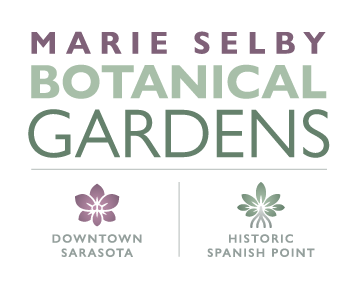Written by Shawn McCourt, Ph.D., Plant Records Keeper
Some of the largest, and showiest, exotic trees planted in parks and gardens here in southwest Florida include several members of the mallow family, the Malvaceae. Among these are the deciduous spring-blooming red silk cotton trees or Bombax ceiba, which were introduced to Florida in 1912 by USDA plantsman extraordinaire David Fairchild under the synonym Bombax malabaricum (U.S. Dept. of Agriculture 1913). The natural range of all Bombax species is east Africa to India and China, Southeast Asia, the Philippines, New Guinea, and Australia, where the trees are found in hot, dry savannahs and river valleys at elevations below 4,500 feet. Silk-cotton trees are fast growing, reaching heights of 160 feet (50 meters) or more with a wide trunk of one to ten feet girth supported by a flared buttress. The trunk is spiny when the tree is young, but the stout, conical spines gradually disappear as the tree ages. Bombax ceiba is the most ornamental of the nine Bombax species known to exist, and Marie Selby Botanical Gardens’ Downtown Sarasota campus is home to three large Bombax ceiba trees. One is planted between the south parking lot and Hudson Bayou, a second is planted just south of the historic Christy Payne Mansion, Selby Gardens’ Museum of Botany & the Arts, and the largest is located on the east side of the Great Lawn that stretches south of the newly-restored Selby House.
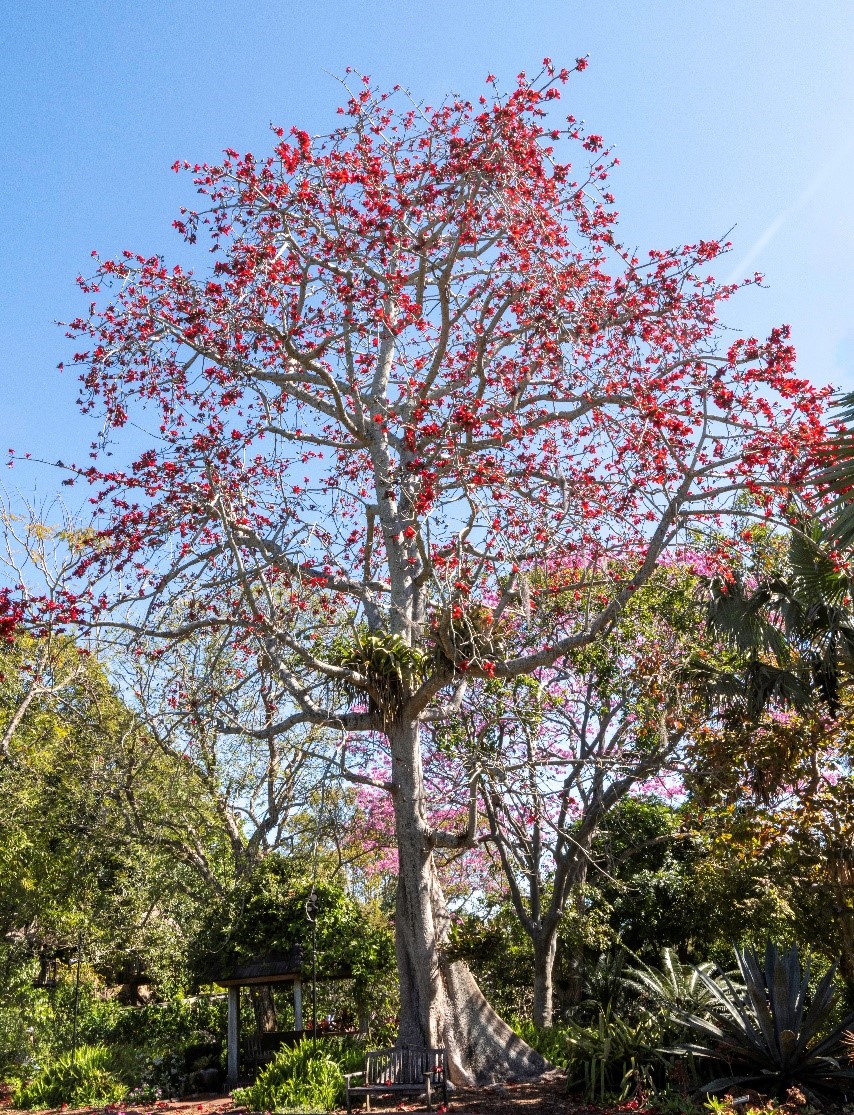
Bombax ceiba currently blooming beside the Great Lawn at Selby’s downtown campus. (Photo by Aaron Fink)
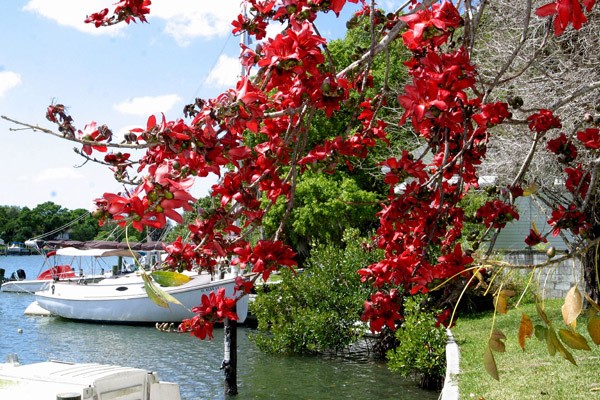
Bombax ceiba growing beside Hudson Bayou at the downtown campus.
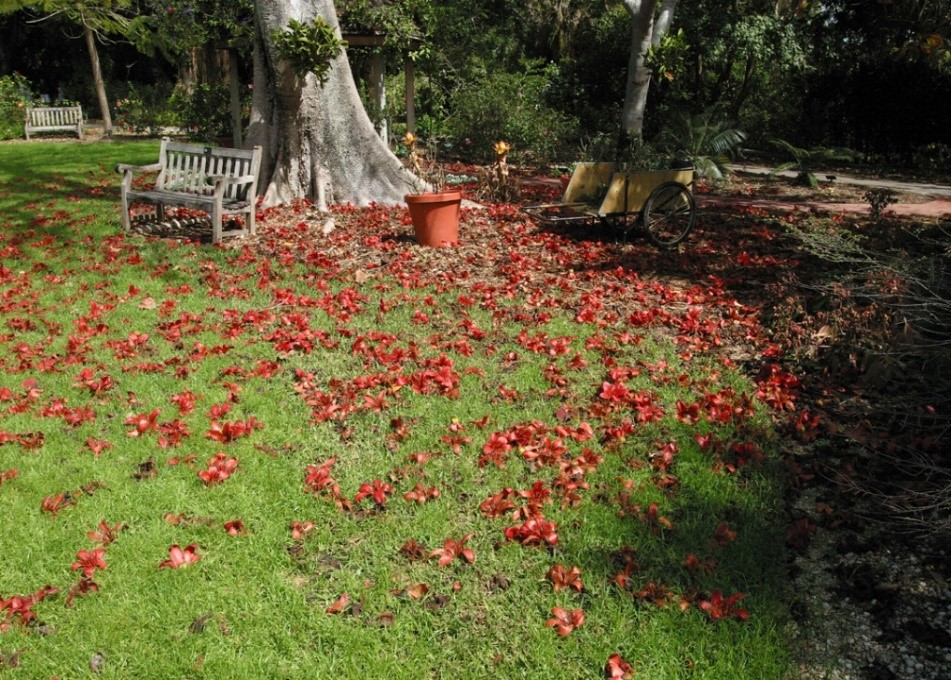
Bombax flowers litter the ground beneath the tree for a few weeks in the spring.
Our trees have spent the winter quietly shedding their leaves and forming fat buds on their naked branches. The large, fleshy, red or orange flowers, which can reach six to eight inches across, explode onto the scene in late February to early March, and are apparently full of sticky nectar much loved by birds, including crows. Though each flower only lasts a day or so, they are borne in rapid succession, so that the tree is constantly covered in blooms during its short three to four week blooming period, and the ground is littered with the heavy flowers. The blooms are later followed by woody, four-angled capsules which split open to release hard, brown seeds encased in the silky, cotton-like “floss” that gives the tree its common name of “silk floss” or “silk cotton”. The genus name Bombax is also derived from cotton, through both the French word bombace (meaning cotton) and Latin bombax (also meaning cotton) which, in turn, was a corruption of the Latin word bombyx (silkworm), derived from the Greek βόμβυξ (bombux– silk or silkworm) (Oxford English Dictionary).
Whether silk or cotton, the name implies that the fibers are useful to the textile industry, however, the fibers found in the capsules of all nine species of Bombax are too short and full of lignin to be useful in weaving. Instead, the trees are cultivated for use of the cotton as insulation, packaging, and stuffing for mattresses, lifejackets and pillows. The soft wood has a variety of uses, a cottonseed-type oil is derived from the seed, a medicinal gum from the bark, and the flowers and their calyces are a staple in some traditional Asian and Indian cuisines. Despite their many potential uses, the trees are mostly valued for their beauty as flowering shade trees and they are widely planted in subtropical and tropical areas around the world. Come see ours blooming this week at the Downtown Sarasota campus.
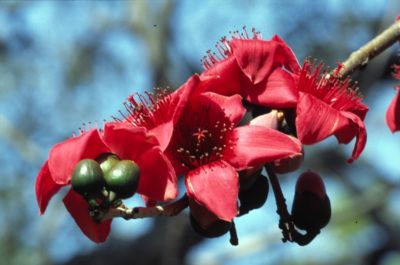
Close-up of Bombax ceiba flowers and buds. (Photo by David McPherson).
Resources:
Atlas of Living Australia (2021). Bombax ceiba. Retrieved 03 March 2021 from https://bie.ala.org.au/species/https://id.biodiversity.org.au/node/apni/2895571
Flora of Pakistan (2021). Bombax ceiba. Retrieved 03 March 2021 from http://www.efloras.org/florataxon.aspx?flora_id=5&taxon_id=242420835.
Missouri Botanical Garden Plant Finder (2021). Bombax ceiba. Retrieved 03 March 2021 from http://www.missouribotanicalgarden.org/PlantFinder/PlantFinderDetails.aspx?taxonid=277961
U.S. Department of Agriculture (1913). Seeds and Plants Imported During the Period from January 1 to March 31, 1912: Inventory No. 30: Nos 32369 to 33278. Bulletin 282. Washington D.C. Retrieved 03 March 2021 from https://www.ars-grin.gov/npgs/pi_books/scans/pi030.pdf.
